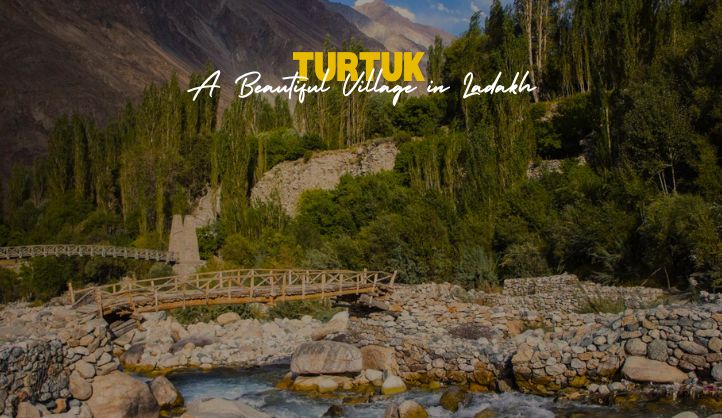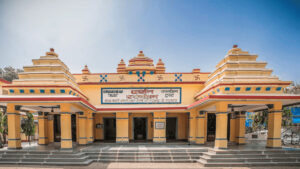Nestled in the majestic Himalayas, Turtuk village is a picturesque village that offers a serene escape from the hustle and bustle of city life. Known for its breathtaking landscapes, rich history, and unique culture, Turtuk has slowly emerged as a must-visit destination for travelers seeking an offbeat experience. Let’s take a closer look at what makes this charming village so special.
Location and How to Reach Turtuk Village
Turtuk is located in the Nubra Valley of Ladakh, close to the India-Pakistan border. Though geographically it is part of Ladakh, it shares cultural and linguistic similarities with Himachal Pradesh. This village is one of the last settlements in India before the Line of Control (LoC) and was opened to tourists only in 2010.
To reach Turtuk, you must first travel to Leh, the capital of Ladakh. From Leh, the journey to Turtuk is an adventure in itself. The drive takes you through Khardung La, one of the highest motorable passes in the world. The distance from Leh to Turtuk is approximately 205 kilometers and can be covered in 6-7 hours by road. You can hire a taxi or join a guided tour to explore the region.
The Natural Beauty of Turtuk Village
Turtuk is blessed with stunning natural beauty. Surrounded by towering mountains, the village sits along the banks of the Shyok River, which flows gracefully through the valley. The lush green fields, apricot orchards, and vibrant flowers add a splash of color to the otherwise rugged landscape.
The cool breeze and tranquil atmosphere make Turtuk a perfect destination for nature lovers and peace seekers. Hiking, birdwatching, and photography are popular activities here. If you’re lucky, you might spot rare Himalayan birds or capture the beauty of snow-capped peaks in the background.
The People and Culture of Turtuk Village
The people of Turtuk belong to the Balti community, an ethnic group that traces its roots to Central Asia. The Balti culture is a unique blend of Tibetan and Islamic traditions. The villagers are warm and hospitable, often inviting travelers to their homes for a cup of tea or a traditional meal.
One of the highlights of visiting Turtuk is experiencing its vibrant culture. The village is known for its traditional festivals, handicrafts, and unique cuisine. Don’t miss trying the local specialties like buckwheat pancakes, apricot jam, and yak butter tea.
Historical Significance of Turtuk Village
Turtuk has a fascinating history. It was part of Pakistan until 1971, when it was reclaimed by India during the Indo-Pak war. This history is evident in the village’s architecture and lifestyle, which reflect a mix of Indian and Pakistani influences.
Visitors can explore the village’s ancient mosques, traditional houses, and the royal palace of the Yabgo dynasty. The village museum, curated by locals, offers a glimpse into Turtuk’s past with artifacts, photographs, and documents.
Best Time to Visit Turtuk Village
The best time to visit Turtuk is between May and September. During these months, the weather is pleasant, with temperatures ranging from 10°C to 25°C. The skies are clear, making it ideal for outdoor activities and sightseeing.
In winter, the village experiences heavy snowfall and extreme cold, which can make travel difficult. However, if you’re an adventure enthusiast, visiting Turtuk in winter can be a thrilling experience.
Things to Do in Turtuk Village
- Explore the Village: Wander through the narrow lanes, visit the local homes, and interact with the friendly villagers.
- Visit the Apricot Orchards: Turtuk is famous for its apricots, and you can taste fresh fruit straight from the trees.
- Hike to the Turtuk Waterfall: A short hike will take you to a beautiful waterfall surrounded by pristine nature.
- Check Out the Turtuk Monastery: This small monastery offers stunning views of the valley.
- Learn History at the Museum: Dive into the village’s history at the Turtuk Heritage Museum.
Nearby Places to Explore Around Turtuk Village
While Turtuk Village itself is a mesmerizing destination, the surrounding areas offer plenty of opportunities to explore the rugged beauty of the Himalayas. Here are some nearby places you can include in your itinerary:
1. Diskit Monastery
Located in the Nubra Valley, Diskit Monastery is one of the oldest and largest monasteries in the region. Perched on a hill, it offers panoramic views of the valley. The highlight of the monastery is the 32-meter-tall Maitreya Buddha statue, which is a symbol of peace and prosperity.
2. Hunder Sand Dunes
Hunder is famous for its unique white sand dunes set against the backdrop of towering mountains. Visitors can enjoy camel rides on the rare double-humped Bactrian camels, a thrilling and memorable experience.
3. Panamik Hot Springs
Situated in the Nubra Valley, Panamik is known for its therapeutic hot springs. The water is rich in sulfur and is believed to have healing properties. Relaxing here after a long journey is truly rejuvenating.
4. Siachen Base Camp
For adventure enthusiasts, a visit to the Siachen Base Camp is an exciting option. Though tourists are not allowed beyond certain points, the journey offers breathtaking views of the glacier and gives a glimpse of the life of soldiers stationed there.
5. Thang Village
Thang is the last Indian village on the Line of Control (LoC). It offers stunning views of the Karakoram Range and the Pakistan-controlled Baltistan region. Visiting this village gives you a deeper understanding of the border dynamics and the resilience of the locals.
6. Sumur Village
Sumur is a peaceful village known for its Samstanling Monastery. Surrounded by lush greenery and picturesque landscapes, it’s a perfect place to unwind and experience the tranquil beauty of Nubra Valley.
7. Yarab Tso Lake
Known as the “Hidden Lake,” Yarab Tso is a pristine, high-altitude lake near Diskit. A short trek from the main road leads to this serene spot, which is perfect for meditation and photography.
8. Khardung La Pass
Khardung La, one of the highest motorable passes in the world, is a must-visit for adventure seekers. The pass offers breathtaking views of the Himalayas and marks the gateway to the Nubra Valley.
Conclusion
Turtuk is more than just a destination—it’s an experience that stays with you forever. Whether you’re drawn by its natural beauty, rich culture, or fascinating history, this charming village has something for everyone. Plan your trip to Turtuk and immerse yourself in the untouched beauty of the Himalayas!
FAQs about Turtuk Village
1. Is Turtuk Village safe for tourists?
Yes, Turtuk is completely safe for tourists. The locals are welcoming, and the Indian Army maintains a strong presence in the region.
2. Do I need a special permit to visit Turtuk?
Yes, Turtuk is close to the India-Pakistan border, so you’ll need an Inner Line Permit (ILP) to visit. These can be easily obtained in Leh.
3. What kind of accommodation is available in Turtuk?
Turtuk offers guesthouses, homestays, and basic hotels. Staying in a homestay is highly recommended to experience the local lifestyle.
4. Can I visit Turtuk village during winter?
While Turtuk village is accessible in winter, the harsh weather conditions make it less suitable for travel. Roads may be blocked due to snowfall.
5. How many days should I spend in Turtuk Village?
A 2-3 day trip is ideal to explore the Turtuk village and its surroundings at a relaxed pace.





